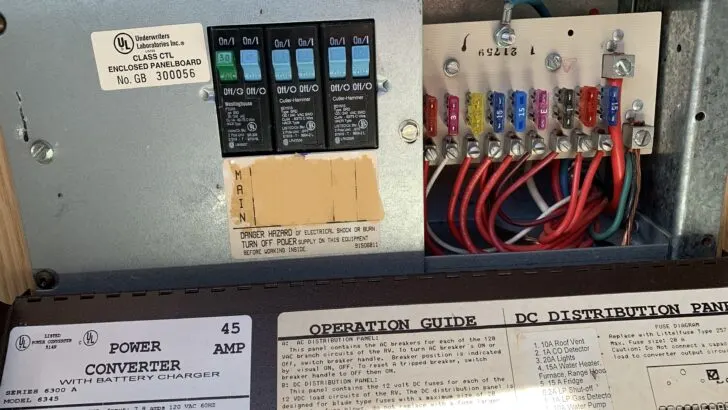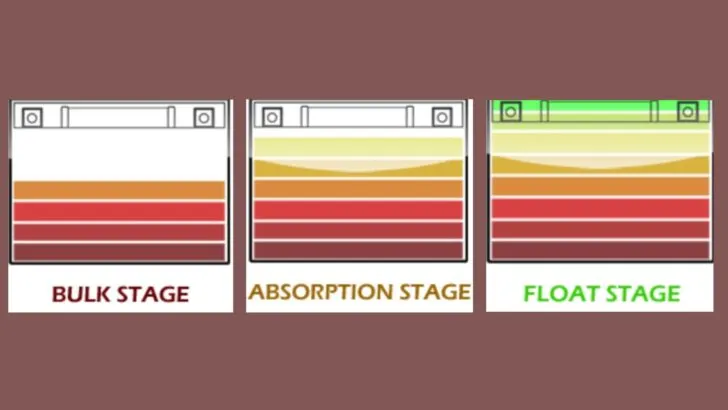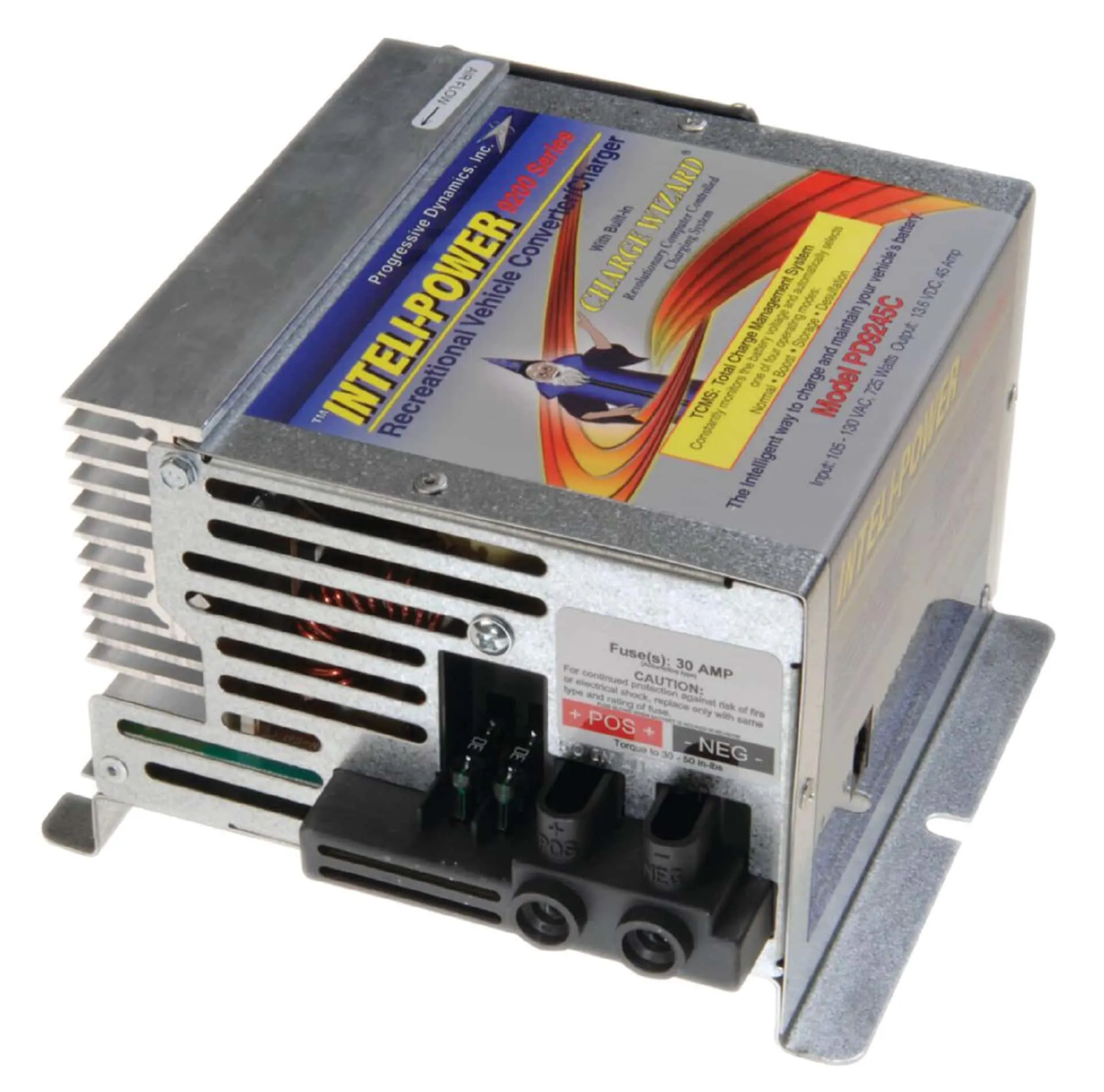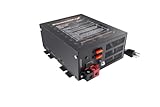In our post on RV power converters, we talked about the differences between an RV power converter, an RV battery charger, and an inverter/charger.
Because these devices and their use can get confusing, we’re dedicating this post to the RV battery charger in hopes that it might clarify the importance of the proper charging of lead-acid batteries, whether they’re flooded, gel, or AGM.
We know that many RVers use lead-acid house batteries. We also know that even basic flooded lead-acid batteries aren’t cheap enough to be considered disposable. But far too many people find themselves needing to replace them after a year or two of use due to mismanagement.
We hope this post will help clarify how to properly charge and maintain lead-acid RV house batteries so they’ll provide reliable power and optimal lifespan. Before switching to lithium batteries, our lead-acid batteries lasted 7 years. We hope yours will last at least that long, too. How? Proper charging and maintenance.
What Is an RV Battery Charger?
An RV battery charger is designed to replace the energy removed from the battery during use, for dependable service and long life. However, not all battery chargers are the same, and ensuring that your batteries are being charged properly is critical to preserving them.
Different types of battery chargers will charge your batteries in different ways. However, if you have lead-acid batteries, (flooded, gel, or absorbed/absorbent glass mat), there’s one type of battery charger that’s far more likely to properly maintain and preserve the life of your batteries.

This is an older 2-stage converter charger in a 1998 Roadtrek Class B RV. A 2-stage charger doesn’t provide optimal charging to today’s batteries.
Newer smart chargers allow the RVer to select the appropriate type of charging for the type of batteries they have, (flooded lead-acid, gel, AGM, or lithium ion), so optimal charging takes place, in stages, as it should.
Confused about RV batteries in general? Check out our RV battery article for a guide to the various types of batteries and their differences.
What Are RV Battery Charging Stages?
First, let’s clarify one important thing — we’re talking about RV house batteries here, not chassis batteries. Chassis/starting/engine batteries start a motorhome’s engine and then stay charged by the alternator all the time. RV house batteries are deep-cycle, designed to be drawn down (to a point), then recharged (that down and up is the “cycle”) as part of regular usage.
House batteries power 12V DC equipment — the water pump, fans, interior lights, etc. They can also power 120V AC appliances (microwave, coffee maker, hair dryer, etc.) through the use of an inverter. It’s an RV’s deep-cycle house batteries that need to be charged in “stages” — and that’s what we’re covering today.
A charger (or converter/charger) may offer 2-stage or 3-stage charging. The charging stages are:
(Voltages are listed for standard 12V flooded lead-acid batteries for example purposes only.)
- Bulk Charge: The first stage of charging in which a high amperage charge is supplied to the battery bank. This stage typically returns 70-80% of the depleted battery capacity. It ends when the battery voltage reaches approximately 14.6V
- Absorption/Acceptance Charge: Once the bulk stage ends, that voltage (14.6V) is maintained while the charger slowly reduces the amperage being supplied. This stage returns the remaining 20-30% of depleted battery capacity and ends when the charging current has reduced to approximately 1% of the battery’s capacity (for instance, a 100 amp-hour battery would be fully charged when the absorption charge current comes down to 1 amp)
- Float Charge: Once the charging amperage drops to a defined target rate (again, typically down to 1% of the battery bank’s capacity), charging voltage is reduced, usually to about 13.6V, to maintain the battery’s charge at 100% of its capacity.

Here you see the three stages of charging illustrated. (Source: Battery Stuff)
How Do Different RV Battery Chargers Work?
Let’s take a quick look at the different types of battery chargers and what kind of charging technology they can provide to your RV batteries.
Single-Stage Chargers
Single-stage RV battery chargers are generally cheaper and use, as the name implies, a single-stage cycle of charging. These typically supply a constant charging amperage until the battery bank reaches a set voltage, and then it shuts off. These are not the optimal way to charge and maintain deep-cycle RV batteries for long life and are normally found on older rigs.
2-Stage Chargers
Again as the name implies, 2-stage chargers replace the battery’s energy in two steps. First, the charger supplies a bulk charge and then it tapers off to a float charge. There is no absorption stage.
In effect, it does the same as a single-stage charger. But once the battery is fully charged, it ramps back to a lower, variable amperage to maintain the battery’s charge.
So, when shore or generator power is supplied, a 2-stage charger will start out in bulk mode, supplying its maximum amperage until the battery’s voltage rises to its target set point (approximately 14.1 to 14.6 volts for flooded lead-acid batteries).
Once that voltage is reached, the charging current is stopped and the battery voltage is allowed to drop to its “float” level (13.6 volts). The charger will supply current as needed to maintain the battery at 13.6 volts.
So, 2-stage chargers supply either full amperage to the batteries or float charge them. Again, this is better than single-stage charging, but the problem is that 2-stage chargers never completely charge a battery to its full capacity, because the bulk stage can only return about 80% of the depleted charge.
All of this tends to increase sulfation and shorten the life of the batteries. Like single-stage chargers, these are often found in older RVs.
Three-Stage RV Battery Chargers
Three-stage charging is really what’s needed to provide a complete recharge for deep cycle RV batteries.

This is a modern 3-stage converter/charger that will charge an RV’s batteries optimally which is beneficial to the health and longevity of the batteries.
A 3-stage charger offers charging in bulk, acceptance/absorption, and float stages. These chargers start out in bulk mode, just like a 2-stage charger does. However, once the battery voltage rises to its target level (14.1–14.6 volts), the charger will hold that voltage while slowly ramping the charging aperage down.
This process, the acceptance/absorption stage, returns the battery to 100% full. Once the battery is fully charged, the voltage is reduced to float level (typically around 13.6 volts), and low current charging is supplied to maintain that voltage level.
This helps to lengthen the battery’s lifespan and eliminates the potential for overcharging them. Most lead-acid battery manufacturers recommend 3-stage charging to bring batteries back to full capacity and extend their useful life. Of course, even well-maintained lead-acid batteries need to be equalized at times.
What Type of Battery Charger Can I Use In an RV?
Both built-in and portable battery chargers can be used on RV batteries, though they really have different purposes.
Built-In
An RV battery charger will often be incorporated into the RV’s “Power Center” module, complete with 120V circuit breakers, 12V fuses, and the battery charger itself.
As we noted in detail in our post on RV power converters, many RVs have a converter/charger. This combination device provides both a converter (120V AC shore/generator power to 12V DC power for onboard loads) and a battery charger (often multi-stage to ensure proper charging).
While functionally similar (both take 120V AC power and convert it to 12V DC), the difference between the converter and charger is primarily their ability to control their output voltage/amperage.
A converter supplies amperage at a fixed voltage (typically 13.6 volts), but that can drop if amperage/power demand is more than the converter can supply. A converter can provide a slower charge rate than a charger, but if left connected for too long, it could overcharge the batteries.
As noted in the section above, a battery charger can provide amperage at varying voltages, based on the battery’s state of charge. WFCO, Progressive Dynamics, and PowerMax are reputable names in battery chargers and converter/chargers.
- Output Power: 55 amps DC output
- Output Current: 55A
- Includes built-in Charge Wizard.Fit Type: Universal Fit
- Reverse battery protection prevents damage from improper battery lead connection
- 🔋 POWERMAX PM3 SERIES CONVERTER - This can charge a battery and/or 12V equipment. With our 3 Stage Smart Charging & adjustable power supply modes,...
- 🔋 AVAILABLE IN WIDE RANGE AMP SIZES - The PowerMax PM3 Series are available in a wide range of amperage sizes, and with 24V, 48V versions, and...
Portable Trickle Chargers
Trickle chargers (especially “Smart” trickle chargers) are appropriate for maintaining an already-charged battery while your rig is in storage. However, these generally aren’t good for day-to-day use to properly recharge an RV’s house battery as it’s being used. Trickle chargers are typically portable units like these:
- Meet the GENIUS10 - Similar to our G7200, just better. It's 17% smaller and delivers over 115% more power. It's the all-in-one universal charging...
- Do more with Genius - Designed for 6-volt and 12-volt sealed lead-acid automotive, marine, RV, powersport, and deep-cycle batteries, including...
- STAY CHARGED: The 10 AMP car battery charger automotive provides a full charge to your machine's battery before automatically switching to float mode...
- CONNECT AND FORGET: With a low maintenance design, our universal vehicle charger and maintainer is compact, lightweight, and easy to operate even in...
Bottom Line
The most important thing to remember about battery chargers or converter/chargers for lead-acid RV house batteries is that 3-stage models are best at providing proper charging, maintenance, and long lifespan.
While any battery charger may fully automatically charge your batteries, 3-stage chargers/maintainers are the best option for doing the job properly. They provide the bulk, absorption, and float charging stages to maintain your battery’s optimal health over the longest period.
Free RVing Tips, Tricks, Reviews, Giveaways & More
Subscribe to our daily newsletter! We’ve been full-time RVers for 20 years (!) and share everything we’ve learned about RVing in our daily blog posts. Join our online community to receive a wealth of great RVing knowledge delivered right to your inbox.
Whether this is your first time on the road or you’re a seasoned full-timer, you’ll love the wide range of RVing topics we cover. Don’t miss a single article or any of our famous RV gear Giveaways — Subscribe today!







Smitty
Tuesday 18th of July 2023
Good coverage/info of this area of RV'ing that can be confusing at times! On the Maintainer side of batteries. I'm probably no different then many RV'er's, and accumulated numerous Battery Minders and Tenders over the years, for different battery support. I think my favorite due to flexibility and ease of use, and lifting above it's weight with the 8A option, is the Battery Minder 128CEC (I have the older unit, now they call it the 128CEC2.). While our coach is in storage, on a 15A outlet, I'm able to maintain X's 6 8D FullRiver AGM's successfully, on the 4A setting. (We have dual 3K inverters, and I only leave the Inverter feeding the Refrigerator on. And the 4A supports the inverter overhead, and 22' Amana fridge demands, keeping the battery bank up. For chassis, X's 2 8D LifeLines - I use a smaller Battery Minder. Which also works well (Can't recall the model...). --- Curious of your thoughts on Desulfator's. Many consider the snake oil, others seem to swear by them... The 128CEC series has this... Opinions on this function would be appreciated. - Best, and travel safe - Smitty
TheRVgeeks
Wednesday 19th of July 2023
Hey Smitty. Thanks for sharing your experience with chargers.
We're sort of on the fence when it comes to the "desulfator" modes. SEEMS like snake oil (i.e. too good to be true), but we've read of lots of people who swear by them. Of course... that's all anecdotal... we haven't seen any scientific proof/evidence to support that. Since we don't have a charger that has that function (and now have Lithium batteries that don't need it), we can't report from personal experience.
But, that said, we don't see how it could HURT... so we'd likely use the feature if it was available to us.
Matt Caldwell
Monday 17th of July 2023
I think my Magnum MS2012 Inverter/Charger actually has a 4th stage - Full Charge. Whenever the Float stage runs for some length of time (I think 4 hours, the Full Charge stage is applied to actually turn OFF the Charger. Is this an added protection of battery life ?
Smitty
Tuesday 18th of July 2023
@Matt Caldwell. I know the MS2812 did this too. The danger on the earlier years of the MS series, is if 'Finish Charge' (Finishing? memory fade..) setting is NOT set to Multi. The logic was for MS2812 to kick back into 'Float Mode' if the 'Voltage' reached lower value, then the Float would run for a One Hour period, before going back to Full Charge/Resting. The problem for many, and it bit us hard, was two key flaws in this logic: 1) The 'lower value' was defaulted for Wet Cells, and was not a customizable setting. The 'low value' for a wet cell, can be way too low for an AGM; 2) It was assumed this was for a smaller bank of batteries (Say X's 2 6V). With a larger bank, say the X's 4 L16's LifeTime's 800AH's we had. One hour of Float... was not even enough to even begin to replenish a the bank that per the lower 'wet cell' voltage that trigged the 'Float' mode on again, to recover. --- We would have out coach in storage for several months a year, and over a 5 year period, this 'Walked Our Bank' down. Sitting undercharged for longer periods of time, sulfate build up on the AGM matts. Note the Shunt Fed SOC reading reported via the ARC50, still reported 100% SOC at this time. (As a slowly draining battery at rest in storage, was not sending AH's out thru the Shunt. The Float for One Hour, was sent to the ARC50 - and thus the reflection of 100% SOC. --- It was after our oversized bank (800AH's was sized to 50-70% over out average daily use of 65-75AH's while boondocking.), had 'walked down' and we started to have performance issues. LifeTime Tech Support, worked with me on the issue. And then they tied in Magnum Tech Support on a three way call - and it was these two great Tech's that finally put the pieces together on the flaw of that one specific setting, in relation to lack of Wet vs AGM setting, and that SOC would have been a better setting to 'trigger' Float back on, and back off. My understanding is that around 2016 or so, Magnum revised the logic of this feature to SOC, and did use the inputted Wet or AGM settings. They could not update existing boards in the MS2812 (Assume all MSxxxx's) prior to this update. BUT, for somewhere around $300, I could have swapped out the control board in our unit. Elected not to, as I set the Finish setting to Multi, which keeps it in Float Mode, vs going to Full Charge/Resting mode. (Lifetime had me due multiple 'Equalizing/Conditioning' cycles on my bank. They came back some, but were too heavily sulfated... 5 1/2 years old, and not even near their DOD Life Cycle usage. Though 6 months out of the 5 year prorated warranty. LifeTime did assist me with replacing all 4 of these L16's - a stand up company! And Magnum? I have no problem with the Tech Support, but do believe if they had updated their instruction manuals on just how the setting of Finishing logic worked, in my era MS2812... I would have been able to avoid self infliction ruining that bank. And they did update the logic. However, I do not believe they revised their manuals on my era unit, and as a 'Warranty Registered' owner of that unit, I saw no email cautioning/clarifying the risks of using that combo of settings... (If I missed this, sorry! But feel they could have done that...). ----- Sorry for the long post. Just wanted to let you know, if your MSxxxx is and older unit - the potential risk on those combo's of settings:)!